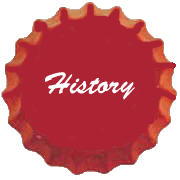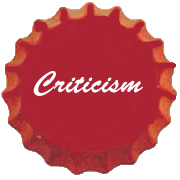Coca-Cola's advertising has significantly affected American culture, and it is frequently credited with inventing the modern image of Santa Claus as an old man in a red-and-white suit. Although the company did start using the red-and-white Santa image in the 1930s, with its winter advertising campaigns illustrated by Haddon Sundblom, the motif was already common. Coca-Cola was not even the first soft drink company to use the modern image of Santa Claus in its advertising: White Rock Beverages used Santa in advertisements for its ginger ale in 1923, after first using him to sell mineral water in 1915.
Before Santa Claus, Coca-Cola relied on images of
smartly-dressed young women to sell its beverages. Coca-Cola's
first such advertisement appeared in 1895, featuring the young
Bostonian actress Hilda Clark as its spokeswoman.
Coca-Cola's
first such advertisement appeared in 1895, featuring the young
Bostonian actress Hilda Clark as its spokeswoman.
1941 saw the first use of the nickname "Coke" as an official trademark for the product, with a series of advertisements informing consumers that "Coke means Coca-Cola".
In 1971, a song from a Coca-Cola commercial called "I'd Like to Teach the World to Sing," produced by Billy Davis, became a hit single.
Coke's advertising is pervasive, as one of Woodruff's stated goals was to ensure that everyone on Earth drank Coca-Cola as their preferred beverage. This is especially true in southern areas of the United States, such as Atlanta, where Coke was born.
Some of the memorable Coca-Cola television commercials between 1960 through 1986 were written and produced by former Atlanta radio veteran Don Naylor (WGST 1936–1950, WAGA 1951–1959) during his career as a producer for the McCann Erickson advertising agency. Many of these early television commercials for Coca-Cola featured movie stars, sports heroes and popular singers.
During the 1980s, Pepsi-Cola ran a series of television advertisements showing people participating in taste tests demonstrating that, according to the commercials, "fifty percent of the participants who said they preferred Coke actually chose the Pepsi." Statisticians were quick to point out the problematic nature of a 50/50 result: most likely, all the taste tests really showed was that in blind tests, most people simply cannot tell the difference between Pepsi and Coke. Coca-Cola ran ads to combat Pepsi's ads in an incident sometimes referred to as the cola wars; one of Coke's ads compared the so-called Pepsi challenge to two chimpanzees deciding which tennis ball was furrier. Thereafter, Coca-Cola regained its leadership in the market.
Selena was a spokesperson for Coca-Cola from 1989 till the time of her death. She filmed three commercials for the company. In 1994, to commemorate her five years with the company, Coca-Cola issued special Selena coke bottles.
The Coca-Cola Company purchased Columbia Pictures in 1982, and began inserting Coke-product images in many of its films. After a few early successes during Coca-Cola's ownership, Columbia began to under-perform, and the studio was sold to Sony in 1989.
Coca-Cola has gone through a number of different advertising slogans in its long history, including "The pause that refreshes," "I'd like to buy the world a Coke," and "Coke is it" (see Coca-Cola slogans).
In 2006, Coca-Cola introduced My Coke Rewards, a customer loyalty campaign where consumers earn points by entering codes from specially-marked packages of Coca-Cola products into a website. These points can be redeemed for various prizes or sweepstakes entries.
Holiday campaigns
The "Holidays are coming!" advertisement features a train of red delivery trucks, emblazoned with the Coca-Cola name and decorated with electric lights, driving through a snowy landscape and causing everything that they pass to light up and people to watch as they pass through.
 The advertisement fell into disuse in 2001, as the Coca-Cola
company restructured its advertising campaigns so that
advertising around the world was produced locally in each
country, rather than centrally in the company's headquarters in
Atlanta, Georgia. However, in 2007, the company brought back the
campaign after, according to the company, many consumers
telephoned its information center saying that they considered it
to mark the beginning of Christmas. The advertisement was
created by U.S. advertising agency Doner, and has been part of
the company's global advertising campaign for many years.
The advertisement fell into disuse in 2001, as the Coca-Cola
company restructured its advertising campaigns so that
advertising around the world was produced locally in each
country, rather than centrally in the company's headquarters in
Atlanta, Georgia. However, in 2007, the company brought back the
campaign after, according to the company, many consumers
telephoned its information center saying that they considered it
to mark the beginning of Christmas. The advertisement was
created by U.S. advertising agency Doner, and has been part of
the company's global advertising campaign for many years.
Keith Law, a producer and writer of commercials for Belfast CityBeat, was not convinced by Coca-Cola's reintroduction of the advertisement in 2007, saying that "I don't think there's anything Christmassy about HGVs and the commercial is too generic."
In 2001, singer Melanie Thornton recorded the campaign's advertising jingle as a single, Wonderful Dream (Holidays are Coming), which entered the pop-music charts in Germany at no. 9. In 2005, Coca-Cola expanded the advertising campaign to radio, employing several variations of the jingle.
Sports sponsorship
Coca-Cola was the first commercial sponsor of the Olympic games, at the 1928 games in Amsterdam, and has been an Olympics sponsor ever since. This corporate sponsorship included the 1996 Summer Olympics hosted in Atlanta, which allowed Coca-Cola to spotlight its hometown. Most recently, Coca-Cola has released localized commercials for the 2010 Olympics in Vancouver; one Canadian commercial referred to Canada's hockey heritage and was modified after Canada won the gold medal game on February 28, 2010 by changing the ending line of the commercial to say "Now they know whose game they're playing".
Since 1978, Coca-Cola has sponsored each FIFA World Cup, and
other competitions organised by FIFA. In fact, one FIFA
tournament trophy, the FIFA World Youth Championship from
Tunisia in 1977 to Malaysia in 1997, was called "FIFA — Coca
Cola Cup". In addition, Coca-Cola sponsors the annual Coca-Cola
600 and Coke Zero 400 for the NASCAR Sprint Cup Series at
Charlotte Motor Speedway in Concord, North Carolina and Daytona
International Speedway in Daytona, Florida. Coca-Cola has a long
history of sports marketing relationships, which over the years
have included Major League Baseball, the National Football
League, National Basketball Association and the National Hockey
League, as well as with many teams within those leagues.
Coca-Cola is the official soft drink of many collegiate football
teams throughout the nation.
In fact, one FIFA
tournament trophy, the FIFA World Youth Championship from
Tunisia in 1977 to Malaysia in 1997, was called "FIFA — Coca
Cola Cup". In addition, Coca-Cola sponsors the annual Coca-Cola
600 and Coke Zero 400 for the NASCAR Sprint Cup Series at
Charlotte Motor Speedway in Concord, North Carolina and Daytona
International Speedway in Daytona, Florida. Coca-Cola has a long
history of sports marketing relationships, which over the years
have included Major League Baseball, the National Football
League, National Basketball Association and the National Hockey
League, as well as with many teams within those leagues.
Coca-Cola is the official soft drink of many collegiate football
teams throughout the nation.
Coca-Cola was one of the official sponsors of the 1996 Cricket World Cup held on the Indian subcontinent. Coca Cola is also one of the associate sponsor of Delhi Daredevils in Indian Premier League.
In England, Coca-Cola is the main sponsor of The Football League, a name given to the three professional divisions below the Premier League in football (soccer). It is also responsible for the renaming of these divisions — until the advent of Coca-Cola sponsorship, they were referred to as Divisions One, Two and Three. Since 2004, the divisions have been known as The Championship (equiv. of Division 1), League One (equiv. of Div. 2) and League 2 (equiv. of Division 3). This renaming has caused unrest amongst some fans, who see it as farcical that the third tier of English Football is now called "League One." In 2005, Coca-Cola launched a competition for the 72 clubs of the football league — it was called "Win a Player". This allowed fans to place 1 vote per day for their beloved club, with 1 entry being chosen at random earning £250,000 for the club; this was repeated in 2006. The "Win A Player" competition was very controversial, as at the end of the 2 competitions, Leeds United AFC had the most votes by more than double, yet they did not win any money to spend on a new player for the club. In 2007, the competition changed to "Buy a Player". This competition allowed fans to buy a bottle of Coca-Cola Zero or Coca-Cola and submit the code on the wrapper on the Coca-Cola website {www.coca-colafootball.co.uk}. This code could then earn anything from 50p to £100,000 for a club of their choice. This competition was favored over the old "Win A Player" competition, as it allowed all clubs to win some money.
Introduced March 1, 2010, in Canada, to celebrate their 2010 Olympics, Coca Cola will sell gold coloured cans in packs of 12 355 each, in select stores.
In mass media
Coca-Cola has been prominently featured in countless films and television programs. It was a major plot element in films such as One, Two, Three, The Coca-Cola Kid, and The Gods Must Be Crazy. It provides a setting for comical corporate shenanigans in the novel Syrup by Maxx Barry. And in music, in the Beatles' song, "Come Together", the lyrics said, "Coca-Cola, he say...".










